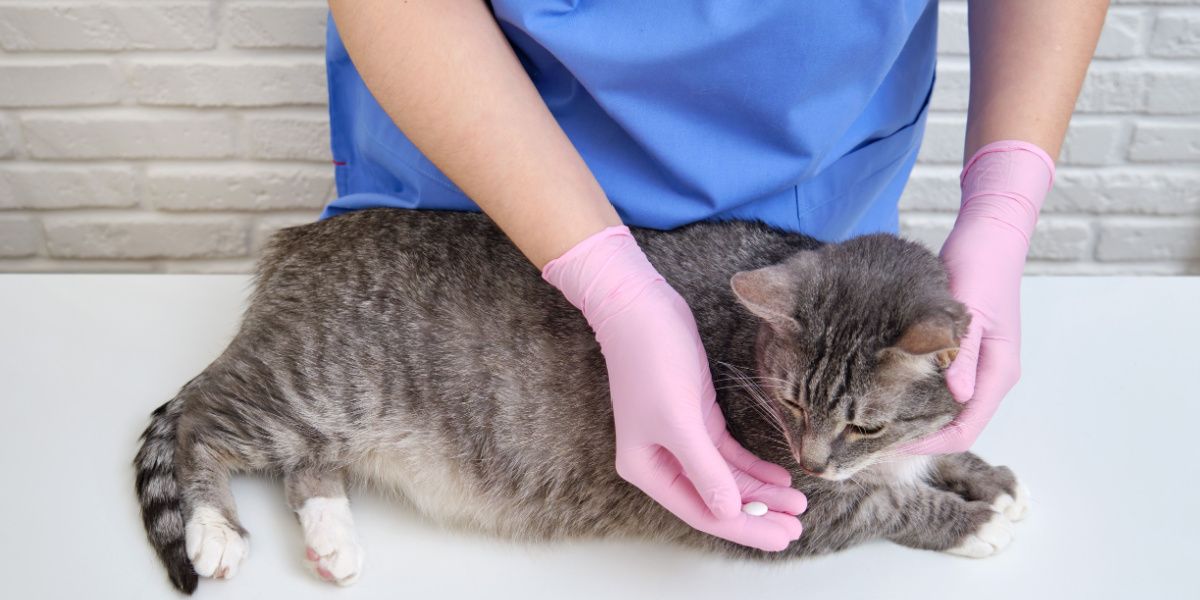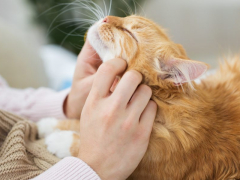
Credelio for cats is an oral flea and tick preventive medication manufactured by Elanco Animal Health. In this article, you’ll learn what Credelio does, how it works, side effects to look for, and some frequently asked questions.
Credelio for Cats Overview

About Credelio for Cats
Credelio Cat is a brand name for a feline product version of lotilaner, manufactured by Elanco Animal Health.
Lotilaner is a member of the isoxazoline class of medications which are very effective at treating and preventing flea and tick infestations. Lotilaner works by inhibiting gamma-aminobutyric acid (GABA)-gated signaling channels in the central nervous systems of insects and ticks.
GABA is an inhibitory neurotransmitter in the body. By blocking GABA channels, lotilaner leads to hyper excitement and rapid death of insects and ticks.
The GABA receptor in ticks and insects has differences in structure and sensitivity compared to the GABA receptor in mammals like cats, dogs, and humans. This is the basis for the perceived safety of isoxazoline medications and why they kill insects and ticks while having limited side effects in pets.
Credelio Cat is FDA approved for use in cats with the following guidelines:
- Treatment for adult fleas and prevention of flea infestations (caused by Ctenocephalides felis) in cats and kittens 8 weeks of age and older
- Treatment and control of infestations caused by the black-legged tick (Ixodes scapularis) in cats and kittens aged 6 months and older.
- Cats must weigh at least 2 lb or more.
- Treatment and control of parasites lasts for 1 month.
It is important to note that Credelio Cat does not provide protection from intestinal parasite worms or from mosquito-borne heartworms.
It is also important to note that Credelio Cat has only shown efficacy for control of Ixodes scapularis (the black-legged tick) in the US. There are several other species of ticks it has not proven effective tick treatment for.
Dose for Cats
There are two dosage sizes for Credelio Cat.
The 12mg size is indicated for cats and kittens weighing 2 lb to 4 lb (0.9kg to 1.8 kg). The 48mg size is for cats weighing 4.1 lb to 17 lb.
For cats weighing over 17lb, the manufacturer advises combining tablets to achieve the most appropriate dose. For example, a 20 lb cat would receive a 48mg tablet plus a 12mg tablet.
How To Administer Credelio to Cats
Credelio for Cats is a chewable tablet with vanilla and yeast flavoring. The medication can be given as a monthly treat.
For cats that may not eat Credelio Cat on its own, the chewable can be administered directly by mouth or can be hidden in food. Since it is in a chewable form, it can be broken into smaller pieces and hidden in food or a treat, as long as it is consumed in one sitting.
Palatability studies showed that of 221 cats, just over 20% ingested the tablet on their own. About 26% of cats ingested the tablet when it was given with food. About 53% of cats needed to have the tablet administered directly by mouth. Fortunately, cat parents in the study were unable to administer Credelio Cat in only 0.5% of cases.
The palatability studies do support that cats can be very picky, especially with medication. If you have tried giving your cat Credelio as a chewable on its own and your cat will not take the medication, here are some links to helpful tips for administering a medication with food or directly by mouth.
Regardless of how a cat consumes the tablet, the manufacturer recommends giving Credelio in close proximity to a meal, as absorption by the body is about nine times better.
Side Effects of Credelio for Cats

According to the manufacturer, in a field study evaluating Credelio Cat where about 230 cats received the medication, no serious adverse reaction events were reported.
A low percentage of side effects were reported during the trial, but the most common included:
- Weight loss (2.2%)
- Tachypnea (increased breathing rate or panting) (1.3%)
- Vomiting (1.3%)
- Diarrhea (0.9%)
- Anorexia (poor appetite) (0.9%)
A safety study was also performed with results provided by the manufacturer. This study involved 24 eight week old cats who received either the labeled dose, 3 times the labeled dose, or 5 times the labeled dose once a month for 8 months. Results were compared to a control group receiving a placebo.
Vomiting was the most common visible effect that was noted which was more in the 5 times group. No clinically significant changes were seen with physical and neurological examinations. Some minor bloodwork changes were found in a couple of the cats in the 3 times and 5 times group.
Neurologic adverse reactions like muscle tremors and seizures were not found during clinical trials or safety studies. However, they have been reported to the FDA for both cats and dogs while on isoxazoline class drugs like Credelio. The FDA has advised that these signs have been reported in cats that have no prior history of seizures or epilepsy. This medication should be used with caution in a cat with a history of neurologic disorders.
Overdose and Emergencies
Based on the safety studies, a cat receiving an overdose would most likely develop signs of vomiting.
If you are ever concerned that your kitty may have developed side effects while using Credelio Cat, or if an overdose is suspected, make sure to immediately contact one or more of the following for advice:
- Your veterinarian
- ASPCA Animal Poison Control Center (1-888-426-4435)
- Pet Poison Helpline (1-855-764-7661)
Potential Drug Interactions With Credelio for Cats

In a field study, lotilaner/Credelio was used together with other medications including vaccines, antibiotics, non-steroidal anti-inflammatory medication, dewormers, and anesthetic medications with no observed side effects.
Because Credelio is only effective against fleas and ticks, it may be combined with another preventive medication for mosquito-borne heartworms and/or intestinal parasites. It is very important when combining products to exercise caution and not use a second product also containing an isoxazoline.
If you have any specific questions about using Credelio with another preventive medication or any other medication, make sure to contact your veterinarian.
Also Read: Flea and Tick Medication Poisoning in Cats: Causes, Symptoms, & Treatment
How To Store Credelio
Credelio Cat chewable tablets should be stored at about room temperature between 59 degrees F and 77 degrees F (15 degrees C to 25 degrees C). The manufacturer indicates that storage temperature fluctuations between 41 degrees F and 104 degrees F are permitted (5 degrees C to 40 degrees C).
Because it is a flavored, chewable medication, it is best to store Credelio in an area out of reach of pets and children.
Drug Dosing Disclaimer: We are only able to provide doses for medications that are FDA approved for use in cats and only as the label guidelines dictate. For medications that are used off-label we can only provide guidelines and safety information for use. Safe and appropriate dosing for off-label medications can only be determined by a primary care veterinarian.
We encourage you to work with your veterinarian to determine if a particular medication is appropriate for your cat. Changing or adjusting a dose for your cat on your own without consulting with a veterinarian can carry risk. We do not encourage use of medications prescribed for human use in pets without first consulting with a primary care veterinarian.
Frequently Asked Questions
Is Credelio a Good Flea Treatment for Cats?
Credelio does appear to be an effective treatment for fleas in cats. According to the manufacturer, in a controlled lab study, Credelio Cat began to kill fleas within 6 hours of administration. Within 12 hours, more than 98% of fleas were killed. In another study, Credelio Cat was 100% effective in killing fleas by 24 hours and remained effective for up to 35 days.
A study also showed that Credelio Cat was effective at killing fleas before they could lay eggs, making it effective at controlling and preventing infestations.
For ticks, Credelio Cat was shown to be over 97% effective at killing black-legged ticks after 72 hours, with the effect lasting for up to 31 days.
What if I Miss a Dose of Credelio for Cats?
Credelio should be administered monthly on about the same date each month. If you miss a dose of Credelio, give the next dose that is due as soon as possible. For future doses, make sure to adjust your calendar so that you are giving future doses every 30 days on the new date each month.
What Are the Side Effects of Credelio for Cats?
The most commonly reported side effects in cats include weight loss, increased breathing or panting, vomiting, diarrhea, and poor appetite. The most common effect seen in cats receiving a dose of Credelio above the labeled dose was vomiting.
Neurologic side effects like muscle tremors or seizures have been reported to the FDA but were not seen with any considerable frequency in field studies and are considered rare. That said, if your cat has a history of neurologic disease, seizures, or epilepsy, many veterinarians would advise against using any isoxazoline medication, including Credelio Cat.
Is Credelio Safe for Cats?
Safety studies for Credelio Cat have shown that it is a safe medication to use for most cats. Because every cat is an individual and can have individual sensitivities to medications, side effects to any medication is always possible.
The potential for neurologic effects have been the concern for many pet parents. While events like muscle tremors and seizures have been reported to the FDA in pets taking isoxazoline medications, safety studies and field trials did not see these effects for Credelio Cat.
Isoxazoline medications work to kill insects and ticks by blocking Gamma aminobutyric acid (GABA) channels in the central nervous system. The GABA channels of insects and ticks are far more susceptible to lotilaner and other isoxazolines while GABA channels for mammals like pets and humans are not, lending to the safety for using these medications.
In pets that develop neurologic effects on isoxazoline medications, the specific cause is not known, but is considered to be very uncommon.
How Long Does it Take for Credelio to Work in Cats?
According to the manufacturer, Credelio began to kill fleas within 6 hours of administration, with greater than 98% of fleas killed by 12 hours. Another study showed all fleas were killed by 24 hours.
For ticks, greater than 97% of black-legged ticks were killed by 72 hours following the administration of Credelio.
In general, the expectation would be that effects of flea and tick protection would be expected within a few hours after administration with full effect and all affected parasites killed within 3 days.
-
Credelio CAT (lotilaner) [package insert]. Elanco US Inc. https://dailymed.nlm.nih.gov/dailymed/fda/fdaDrugXsl.cfm?setid=365b701f-e9a8-458f-90ff-33ca1fb947ca
-
US Food and Drug Administration. Fact Sheet for Pet Owners and Veterinarians about Potential Adverse Events Associated with Isoxazoline Flea and Tick Products. Last updated August 13, 2021. https://www.fda.gov/animal-veterinary/animal-health-literacy/fact-sheet-pet-owners-and-veterinarians-about-potential-adverse-events-associated-isoxazoline-flea
-
Plumb DC. Lotilaner. In: Plumb DC, ed. Plumb's Veterinary Drug Handbook. 9th ed.







